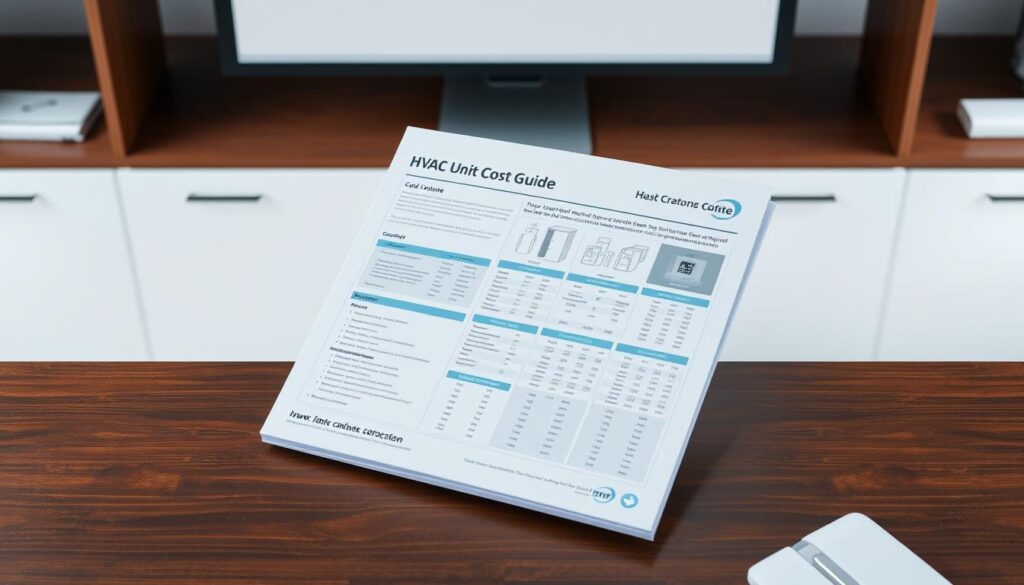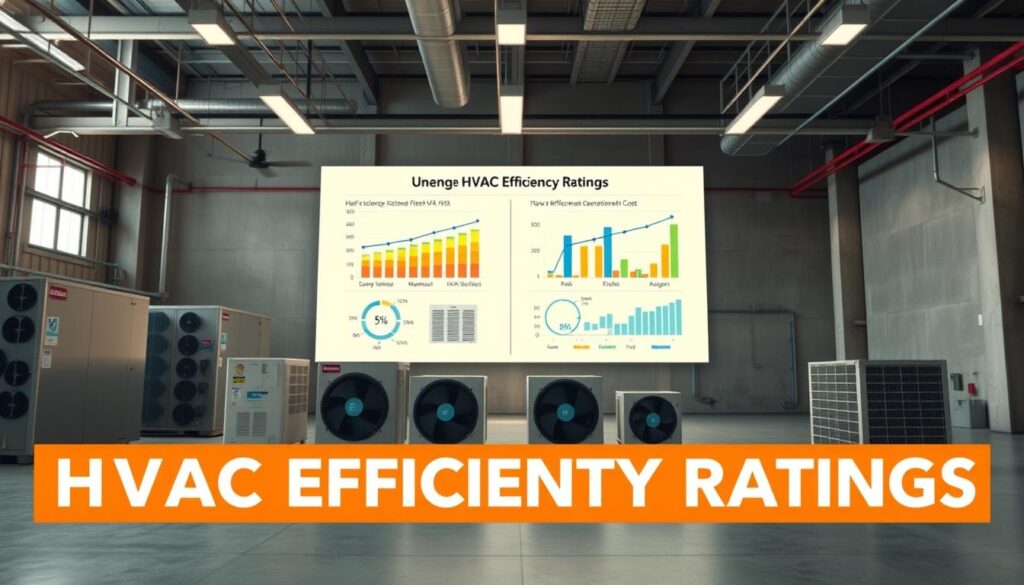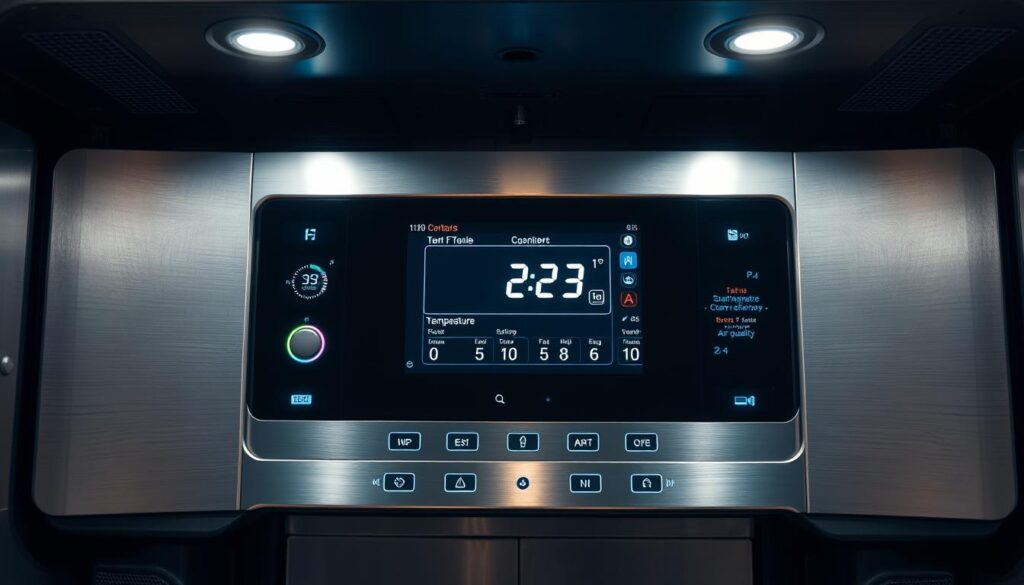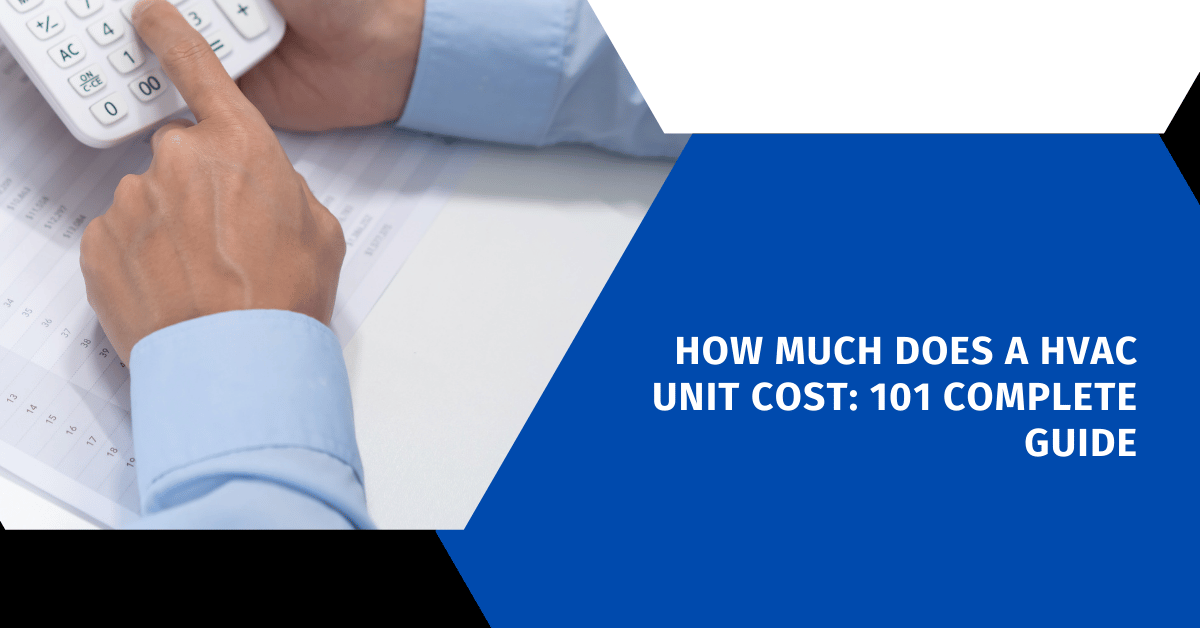Affiliate Disclosure
HVAC Guide Guys is a participant in the Amazon Services LLC Associates Program, an affiliate advertising program designed to provide a means for sites to earn advertising fees by advertising and linking to Amazon.
How Much Does a HVAC Unit Cost? Are you curious about the cost of a new HVAC system? Choosing to replace your home’s heating and cooling can seem daunting. The prices might surprise you.

Knowing the cost of HVAC units is key for homeowners looking to improve their comfort. Installing a central air conditioning unit can cost between $3,300 and $7,800. Several factors can change this price a lot.
This guide will cover all you need to know about HVAC unit costs. It aims to help you choose wisely, balancing your budget with your home’s comfort needs.
Key Takeaways
- Average HVAC installation costs range from $3,300 to $7,800
- System type and home size dramatically influence pricing
- Energy efficiency can impact long-term cost savings
- Professional installation is critical for optimal performance
- Consider both upfront and ongoing maintenance costs
Table of Contents
Understanding HVAC System Types and Their Price Ranges
When looking at central air conditioning costs, you’ll find many HVAC systems. Each has its own features and installation prices. These can affect your comfort and budget.
Knowing about different HVAC systems helps you choose the best for your home. Let’s explore the most common ones available.
Central Air Conditioning Systems
Central air systems are a classic choice for many homes. They cool your entire house through a network of ducts. Prices range from $3,000 to $7,000, based on your home’s size and needs.
- Whole-house cooling coverage
- Consistent temperature control
- Integrated with existing ductwork
Heat Pump and Split Systems
Heat pumps are great for both heating and cooling. Split systems are good for homes without a lot of ductwork.
| System Type | Average Cost | Key Features |
|---|---|---|
| Standard Heat Pump | $4,000 – $8,000 | Year-round temperature control |
| Split System | $2,500 – $6,000 | Zoned cooling capabilities |
Ductless mini-split Options
Ductless mini-split systems are perfect for unique or small homes. They offer individual cooling and are more affordable.
- Perfect for room additions
- Energy-efficient design
- Easy installation process
Choosing the right HVAC system depends on your home, budget, and cooling needs. It’s wise to talk to a professional to find the best fit for your space.
Explore Our HVAC Shop
Looking for top-rated HVAC tools, parts, and accessories? Visit our shop and find the perfect solution for your needs.
Visit the ShopHow Much Does a HVAC Unit Cost
When planning a new HVAC installation, budgeting is key. The cost of new HVAC systems has changed, influenced by various factors in 2025. Knowing the current market helps you make smart choices for your home comfort.
Average Cost Breakdowns by System Type
HVAC installation prices differ based on the system type. Here’s a detailed look at expected costs:
| HVAC System Type | Cost Range |
|---|---|
| Central Air Conditioning | $3,000 – $7,000 |
| Split Air Conditioning | $2,500 – $7,500 |
| Heat Pump | $3,500 – $8,500 |
| Furnace | $2,500 – $7,500 |
| Boilers | $3,500 – $7,500 |
| Ductless Min-Split | $2,000 – $7,000 |
Key Installation Cost Factors
Several elements affect your total HVAC installation cost:
- Home square footage
- System complexity
- Existing ductwork condition
- Regional labor rates
- Equipment efficiency ratings
Additional Equipment Expenses
Think about extra costs for smart technology and other components. Smart thermostats, air purification systems, and zoning can raise the initial cost. But, they might save energy in the long run.
Looking at different quotes can help you find the best price for your HVAC needs.
Factors Affecting HVAC Installation Prices
Knowing about heating system replacement costs is key to a smart HVAC investment. Several important factors affect the total cost of your HVAC installation. Each factor plays a big role in setting the final price.
Your home’s unique features greatly impact the cost. Key factors include:
- Home Size and Layout: Bigger homes need more powerful systems, raising costs
- System Efficiency Ratings: Higher SEER ratings cost more upfront but save money in the long run
- Ductwork Condition: Changes to existing ducts can greatly affect your investment
- Geographic Location: Your area’s climate and labor rates also affect prices
The complexity of your installation is also important. Older homes might need electrical or structural changes. These can unexpectedly increase your costs. HVAC pros will check these needs during the first visit.
Your climate zone is key in choosing the right system. Areas with extreme weather need stronger HVAC systems. This can increase your costs.
Understanding these factors can save you thousands in unexpected costs.
To get the most from your HVAC investment, get several quotes. Also, think about each system’s long-term efficiency.
Explore Our HVAC Shop
Looking for top-rated HVAC tools, parts, and accessories? Visit our shop and find the perfect solution for your needs.
Visit the ShopHVAC Efficiency Ratings and Their Impact on Cost
Knowing your HVAC system’s efficiency is key to understanding heating and cooling costs. The right efficiency rating can greatly affect your costs, both now and in the future.

Efficiency ratings show how well your heating and cooling system works. They help homeowners choose wisely, saving on energy and money.
SEER Ratings Explained
The Seasonal Energy Efficiency Ratio (SEER) is important for air conditioners. Higher SEER means more efficient units that use less energy. SEER ratings range from 14 to 22, with higher numbers being better.
- SEER 14-16: Standard efficiency
- SEER 17-19: High efficiency
- SEER 20-22: Premium efficiency
Energy Efficiency vs. Initial Investment
Choosing a high-efficiency HVAC system is about weighing upfront costs against long-term savings. Even though efficient units cost more at first, they save you money in the long run.
| SEER Rating | Initial Cost | Annual Energy Savings |
|---|---|---|
| 14 SEER | $3,000 – $5,000 | Baseline |
| 16 SEER | $4,500 – $7,000 | 10-15% savings |
| 20 SEER | $6,000 – $9,000 | 25-30% savings |
Long-term Savings
Choosing a high-efficiency system can save you a lot of money over time. For instance, switching from a 14 SEER to a 20 SEER unit can save hundreds each year.
“Energy efficiency is not just about saving money, it’s about reducing your environmental footprint.” – Energy Star Representative
When looking at furnace and air conditioner prices, think about the total cost, not just the initial price. A more efficient system can pay for itself through lower energy bills.
Choosing the Right Size HVAC System for Your Home
When you buy a home HVAC system, picking the right size is key. It’s not about how big the unit is. It’s about its cooling power, measured in British Thermal Units (BTUs).
To understand hvac unit pricing, you need to know how to size your system right. The wrong size can cause big problems:
- Oversized units waste energy by turning on and off too much
- Undersized units can’t cool your home well
- Choosing the wrong size means spending more money in the long run
HVAC experts use the Manual J load calculation to find the perfect size. They look at several things:
- How big your home is
- How well it’s insulated
- The size and number of your windows
- The weather in your area
| Home Size (sq ft) | Recommended BTUs | Typical System Size |
|---|---|---|
| 1,000-1,500 | 18,000-24,000 | 1.5 tons |
| 1,500-2,000 | 24,000-30,000 | 2 tons |
| 2,000-2,500 | 30,000-36,000 | 2.5 tons |
Always work with a certified HVAC contractor to get the best size for your home. They’ll help you make a smart choice. This choice will keep your home comfortable and save energy for years.
HVAC Compressor Types and Their Costs
Understanding compressor types is key when looking at heating and cooling costs. Different compressors affect the price of furnaces and air conditioners. This impacts both the cost at first and how well they work over time.
Compressor technology is vital for your home’s comfort and energy use. Each type has its own benefits and costs. These factors help decide what HVAC system is best for you.
Single-Stage Compressor Systems
Single-stage compressors are the simplest and often the cheapest for homeowners. They work at full power all the time. This means:
- Lower upfront costs for furnace and air conditioner prices
- Simple, straightforward operation
- Less energy-efficient compared to advanced technologies
Two-Stage Compressor Options
Two-stage compressors offer more flexibility in heating and cooling costs. They have two modes:
- Low-stage operation for mild temperatures
- High-stage operation for extreme weather conditions
- Improved energy efficiency compared to single-stage systems
Variable-Speed Technology
Variable-speed compressors are the most advanced and efficient. They adjust their speed to match your home’s cooling needs. The main benefits are:
- Maximum energy efficiency
- Precise temperature control
- Highest initial investment among compressor types
Your choice should balance the initial cost with long-term savings and comfort needs.
Explore Our HVAC Shop
Looking for top-rated HVAC tools, parts, and accessories? Visit our shop and find the perfect solution for your needs.
Visit the ShopSigns It’s Time to Replace Your HVAC System
Knowing when to replace your HVAC system can save you a lot of money. Your home’s comfort and energy efficiency depend on a good heating and cooling system.
There are key signs that show it’s time for a new HVAC installation:
- System Age: Most HVAC units last between 15-20 years
- Increasing Energy Bills: Sudden spikes in monthly costs
- Frequent Repair Needs: Constant breakdowns and maintenance
- Uneven Temperature Distribution: Some rooms too hot or cold
The cost of a new HVAC system might seem high. But fixing an old system over and over can cost even more. Older systems use more energy, raising your utility bills.
| System Age | Replacement Recommendation |
|---|---|
| 10-15 years | Consider evaluation |
| 15-20 years | Strong replacement recommendation |
| 20+ years | Immediate replacement needed |
Listen to unusual noises, watch for inconsistent cooling, and monitor your energy bills. These signs often mean your HVAC system is nearing the end of its life and needs to be replaced.
Proactive replacement can prevent unexpected breakdowns and costly emergency repairs.
Additional Features and Smart Technology Costs
Modern home hvac systems now come with advanced technologies. These features make your ac unit more than just a purchase. They turn it into a smart home upgrade.

Today’s HVAC systems do more than just control temperature. They use smart tech to make your home more comfortable. They can also help save on energy costs over time.
Smart Thermostats and Controls
Smart thermostats are a big step up in managing your home’s climate. They offer many benefits:
- Learn your temperature preferences automatically
- Adjust settings remotely via smartphone apps
- Provide detailed energy consumption reports
- Potential energy savings up to 15%
Air Purification Systems
Good indoor air quality is key for homeowners. Advanced air purification systems can:
- Remove allergens and pollutants
- Reduce airborne contaminants
- Improve respiratory health
- Integrate seamlessly with existing HVAC systems
Zoning Capabilities
Zoning technology lets you control temperature in different areas of your home. This feature allows:
- Independent room temperature settings
- Reduced energy waste
- Enhanced personal comfort
- Customized climate management
Adding these advanced features might raise your initial ac unit installation costs by 5-15%. But, the long-term benefits often make it worth it.
Explore Our HVAC Shop
Looking for top-rated HVAC tools, parts, and accessories? Visit our shop and find the perfect solution for your needs.
Visit the ShopRegular Maintenance Costs and Long-term Investment
Keeping your HVAC system in top shape is key to saving money. Regular maintenance stops sudden breakdowns and makes your system last longer. It’s a smart move for homeowners.
Knowing how much maintenance costs each year helps you plan your budget. Different systems need different levels of care:
- Central Air Conditioning: $150-$500 annually
- Heat Pump Systems: $150-$500 per year
- Furnace Maintenance: $100-$400 yearly
- Ductless Systems: $100-$400 per service cycle
Make sure to include important tasks in your maintenance routine:
- Monthly air filter replacements
- Seasonal professional inspections
- Cleaning internal components
- Checking refrigerant levels
| Maintenance Task | Estimated Cost | Frequency |
|---|---|---|
| Professional Tune-up | $75-$250 | Annually |
| Air Filter Replacement | $10-$50 | Every 1-3 months |
| Comprehensive System Check | $150-$500 | Bi-annually |
Regular maintenance can cut your heating and cooling costs by up to 40%. By investing in regular service, you avoid expensive repairs and keep your system running smoothly. This protects your investment in your HVAC system.
Conclusion
Exploring the cost of a hvac unit shows it’s more than just the price. Your choice of home hvac system depends on several factors. These include the type of system, its efficiency, and the cost of running it over time.
Looking at HVAC prices means you can’t just look at the initial cost. Systems that save energy might cost more at first but save you money later. Knowing about SEER ratings, compressor types, and the right size for your home helps you choose wisely.
Choosing the right HVAC system affects your home’s comfort, air quality, and energy use. Getting it installed right, keeping it maintained, and adding smart features can make it work better. Think of a good HVAC unit as a long-term investment in your home’s comfort and energy efficiency.
With all this knowledge, you’re ready to make a smart choice. You know about different systems, how efficient they are, and extra features. This will help you find an HVAC solution that fits your needs and budget.

